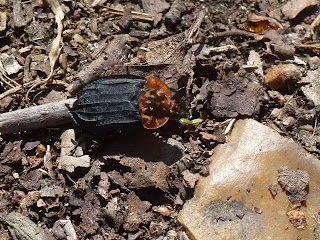It was a perfect spring day at Norfolk Wildlife Trust’s Foxley Wood nature reserve, timed to enjoy spring woodland flowers at around their best. Even around the car park we found lots of common dog violets. A dog’s mercury we looked at had distortion and swelling on a leaf, likely to be caused by a rust fungus Melampsora populnea.
 |
| Foxley Wood in the sunshine. |
Just around the corner, a willow warbler sang in full view. It’s an ideal time to see a willow warbler: freshly arrived, keen to sing to establish territory and easy to see before leaves emerge on trees. Other warblers singing this morning were chiffchaffs and blackcaps. It wasn’t a day for seeing a lot of birds though we did have good views of two marsh tits and heard mistle thrush.
Mostly this was a morning for enjoying glorious weather and spring flowers. Water avens was beginning to bloom in damp patches on the wide rides. Wood anemones and wood sorrel were expected but lovely anyway. Bluebells were in bud or just coming into flower, in great carpets once we’d reached the coppiced area, just after we’d bumped into an NWT team taking a break from working on the electric fence that protects coppice from browsing deer. Bugle in bid, patches of greater stitchwort and endless lesser celandine added variety.
 |
| Wood anemones. |
Brimstones, orange tips and peacocks were all much in evidence. A beetle on the path was an invertebrate curiosity: this was later named as red-breasted carrion beetle Oiceoptoma thoracicum. According to Brock’s book, adults and larvae of this species feed on other insects in dung and carrion.
 |
| Red-breasted carrion beetle. |
A moth with an obviously orange underwing was later named as, er, orange underwing Archiearis parthenias. Day-flying and strongly tied to the presence of birches: sometimes going up the learning curve is easier than other times! In grassy areas, there were plenty of bees, especially red-tailed and buff-tailed bumblebees.
Foxley Wood is a great place for fungi enthusiasts in autumn. Not so in spring, though today we found hoof (or tinder) fungus on birch. This was the species found on Otsi the Iceman, presumably for its tinder qualities. James Emerson tells me that, “It was present in Norfolk before the last ice age, but has recolonised in the past 10-15 years, starting in the west in places like Dersingham.”
 |
| Hoof or tinder fungus. |
We failed to find herb paris though that was more than compensated for by Cheryl being alert to an early purple orchid coming into flower. I don’t recall seeing one in flower in April, in the UK.
 |
| Early purple orchid. |






Photos also on Honeyguide's Facebook: https://www.facebook.com/media/set/?vanity=HoneyguideWildlifeHolidays&set=a.3824135767669341
ReplyDelete